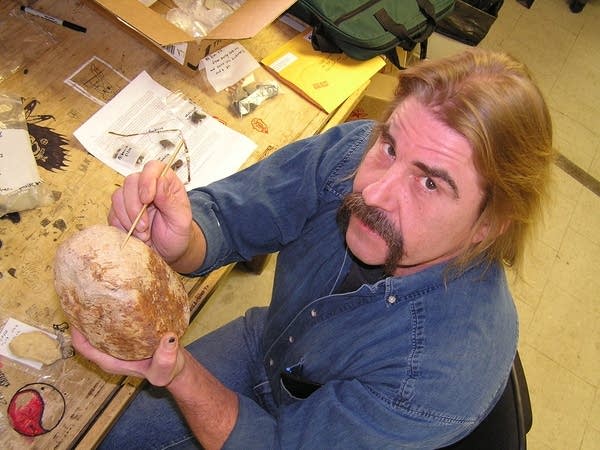Archeological find in Walker may be one of oldest human sites

The ancient stone tools were found on a rugged, jackpine-forested hilltop not far from the shore of Leech Lake. Archeologists from the Leech Lake Heritage Sites Program were there in the fall of 2005 doing a routine survey on a road construction site.
Things got strange when the crew came across a small, cellar-like hole in the ground. At first they thought the hole might be a remnant of the fur trade. They called in Matt Mattson, a local expert in fur trade archeology, to check it out.

When Mattson unearthed a cap gun and an Orange Crush bottle cap, he and others quickly concluded that kids had dug the hole decades ago, probably in the late 50s or early 60s, to make an underground fort.
But when they dug a little deeper, Mattson and the Heritage Sites crew found something else - a flake of stone that appeared to have been intentionally chipped away from a larger piece of rock.
Create a More Connected Minnesota
MPR News is your trusted resource for the news you need. With your support, MPR News brings accessible, courageous journalism and authentic conversation to everyone - free of paywalls and barriers. Your gift makes a difference.
"And that was one of those uh-oh moments where, this doesn't fit," said Mattson. "It's the wrong place. It's the wrong depth. And right there we realized something wasn't fitting a normal pattern, as it were."
The Leech Lake Heritage Sites Program continued digging over the next few months on the one-acre site. They uncovered some 50 artifacts, mostly crude stone tools used for chopping, cutting or scraping. They're being studied at a lab in Cass Lake.
What makes these tools so astounding is their apparent age. Archeologists believe they could have been used between 13,000 and 15,000 years ago, toward the end of the last Ice Age. That was a time when woolly mammoths, mastodons and giant beavers roamed the continent and much of Minnesota was covered by glaciers.

The artifacts require much more analysis, according to Thor Olmanson, director of the Leech Lake Heritage Sites Program, a for-profit company owned by the Leech Lake Band of Ojibwe. Olmanson, who is the principal investigator at the Walker site, says that analysis is needed before the apparent age of the site will be broadly accepted by the scientific community.
"The initial response is doubt and skepticism, because it's commonly understood that there just isn't anything intact in glacial deposits," said Olmanson. "We're still in the process of analysis of the artifacts and the deposits themselves. So far, the only real indication of the age of the site is the soil deposits themselves, which we have on good authority are quite ancient."
If those early age estimates hold true, it puts researchers into uncharted territory. It means humans inhabited Minnesota more than 5,000 years earlier than scientists once thought.
It's possible those early humans may have been able to see huge glaciers from that hilltop in Walker, according to David Mather, an archeologist with the Minnesota Historical Society.
"We'd always imagined people first colonizing what became the state of Minnesota after the glaciers had melted," said Mather. "But this gives us a pretty vivid picture, assuming this all holds up, of people living maybe on the margins of glaciers of what's now northern Minnesota."

Mather says he's worried about the future of the Walker site. Right now, it's in the direct path of a road the city wants to build this summer. However, the city hasn't taken ownership of the land yet. That makes the legalities regarding preservation unclear. Mather says, ultimately, scientists will want to study the site for years to come.
"Regardless of the specific age, which does seem to be very, very ancient, this is the only one we know of, and we didn't think it was even possible for it to exist here," Mather said. "So if we destroy the only one, then there's no chance, really, for the research or the peer review."
The Walker City Council hasn't met yet to discuss its options. Mayor Brad Walhof says officials learned of the archeological discovery just this month.
"I was shocked that something like this would be found in our community," said Walhof. "If, in fact, this is the find they say it is, we could have been a tourist attraction for 15,000 years."
Walhof says if the city's $1.3 million road project can't skirt around the archeological site, the road would likely dead end. That would effectively end the city's plan for a major residential and business expansion down the hill.
Walhof says the silver lining is that Walker will find new fame among history buffs.
"It's been the talk of the town within the last several weeks," said Walhof. "A lot of people are already talking about how this could possibly be a big attraction that people would want to come and see. I mean, something like this comes along how often? Once every 15,000 years."
The Walker City Council plans to meet Feb. 5 to decide how to proceed with it's proposed expansion project.
Assuming the site is preserved, archeologists want to do more digging. But part of the area would likely be set aside for scientists of the future to explore with more sophisticated technologies.


